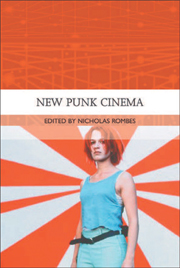Book contents
- Frontmatter
- Contents
- Notes on the Contributors
- Acknowledgements
- Introduction
- PART I BACKGROUNDS AND CONTEXTS
- PART II SCREENING NEW PUNK CINEMA
- 5 DVD and the New Cinema of Complexity
- 6 Digital Technologies and the Poetics of Performance
- 7 Navigating Chaos
- 8 Non-linear Narrative
- 9 Making it Real
- PART III CASE STUDIES
- Bibliography
- Index
5 - DVD and the New Cinema of Complexity
from PART II - SCREENING NEW PUNK CINEMA
Published online by Cambridge University Press: 05 August 2013
- Frontmatter
- Contents
- Notes on the Contributors
- Acknowledgements
- Introduction
- PART I BACKGROUNDS AND CONTEXTS
- PART II SCREENING NEW PUNK CINEMA
- 5 DVD and the New Cinema of Complexity
- 6 Digital Technologies and the Poetics of Performance
- 7 Navigating Chaos
- 8 Non-linear Narrative
- 9 Making it Real
- PART III CASE STUDIES
- Bibliography
- Index
Summary
Film, as we have known it for over a century, began its death in the later 1970s. Though it still exists, it is no longer what it was prior to this, and never will be again. Its death continues to be awkward and, religious connotations aside, if this death is to result in a resurrection we must, firstly, remove the veil of nostalgia that attaches itself to the picture palace and celluloid era and we must, secondly, embrace a new way of understanding and reading the moving image and its attendant sounds, styles and strategies, as well as its technical meta-text.
Unlike the background to the emergence of the punk movement, which occurred in the same period, the death of cinema was not produced by disaffection with establishment practices or, indeed, by a promotion of a philosophy of amateurism; paradoxically, cinema's death was brought about by an over-affection for the mainstream (in cinema's case represented largely by the professional operations of Hollywood). By ‘cinema’ I should differentiate here between that building we know as ‘the Cinema’ and the art-form we know as ‘cinema’ or ‘film’. That building, the Cinema, has adapted to the prevailing post-1970s' conditions to incorporate a broader public entertainment ideal and a discourse of choice; the movie multiplex is the prime example of this. Likewise, because of the changes of the past thirty years, neither ‘film’ nor ‘cinema’ is now an entirely suitable term for the visual and aural medium we're discussing; for the moment, however, both, or either, words will have to do.
- Type
- Chapter
- Information
- New Punk Cinema , pp. 89 - 101Publisher: Edinburgh University PressPrint publication year: 2005



